

A one-of-a-kind marketplace from Steven Soderbergh. - Extension 765. (Note: This posting is for educational purposes only.)
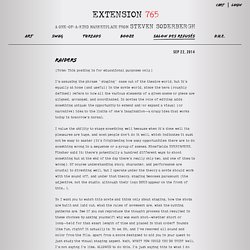
I’m assuming the phrase “staging” came out of the theatre world, but it’s equally at home (and useful) in the movie world, since the term (roughly defined) refers to how all the various elements of a given scene or piece are aligned, arranged, and coordinated. In movies the role of editing adds something unique: the opportunity to extend and/or expand a visual (or narrative) idea to the limits of one’s imagination—a crazy idea that works today is tomorrow’s normal. Buscando a Gilles: Deleuze y la Imagen Cristal (1 y 2) Como dije, terminé, pero no voy a subir todo de una vez porque aún tengo que revisar.

A one-of-a-kind marketplace from Steven Soderbergh. - Extension 765. A one-of-a-kind marketplace from Steven Soderbergh. - Extension 765. Explore the Cinematic Techniques Steven Spielberg Used in 'Raiders of the Lost Ark' Director Steven Soderbergh recently removed the color from Steven Spielberg's Raiders of the Lost Ark to explore the film's staging, and here to provide us with more educational treasures is editor Vashi from Vashi Visuals, who shared a number of his own videos that break down some of the techniques used by Spielberg.
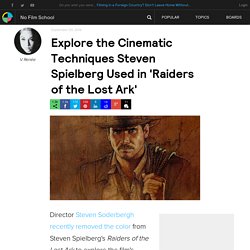
In this video, Vashi explores how Spielberg uses only 12 shots to effectively and interestingly introduce the audience to the film's hero, Indiana Jones -- without the use of dialog. We've all heard the unofficial golden rule of filmmaking "Show, don't tell" -- try not to use dialog and exposition to tell your story if you can use cinematography and visuals -- or at least as much as you can (not hating on dialog here). That way, your audience is given the chance to partake in the thrilling experience of storytelling -- putting two and two together, solving the puzzle -- instead of just being given all of the answers. Alfred Hitchcock - The Master of Suspense. Film Studies For Free: On 'Affect' and 'Emotion' in Film and Media Studies. Emotion is a phenomenon that, according to [Sergei] Eisenstein, "is completely identical with the primary phenomenon of cinema.

[In cinema] movement is created out of two motionless cells. Here, a movement of the soul, i.e. emotion (from the Latin root motio = movement), is created out of the performance of a series of incidents. " ([Towards a Theory of Montage] 145, emphasis in original). Properly structured as a series of uncompleted incidents, montage calls on us to finish the actions mentally, and for Eisenstein this internal movement of filling in the gaps is emotion, a movement of the soul. [Greg M. [H]ow to write about specific, personal affective experiences of the cinema? Film Structure and the Emotion System is concerned with this emotion system's structure, rather than with particular emotions themselves.
La influencia de la pintura en el cine. Slavko Vorkapich - Writer - Films as Director of Montage Sequences:, Films as Director (shorts):, Films as Actor:, Other Films: Special Effects Technician and Director.
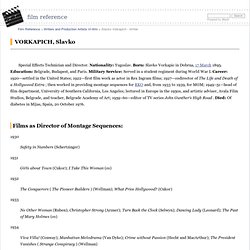
Nationality: Yugoslav. Born: Slavko Vorkapic in Dobrna, 17 March 1895. Education: Belgrade, Budapest, and Paris. Military Service: Served in a student regiment during World War I. The Surreal World of Slavko Vorkapich – Bright Lights After Dark. School of Cinematic Arts Events. OUTSIDE THE BOX [OFFICE] invites you to a special lecture and video presentation by Harvard Professor Vlada Petric A lecture about the legacy of Slavko Vorkapich 7:00PM on Wednesday, April 15th, 2009.

Russian Archives Online. ESTÉTICA DE LA NATURALEZA EN EL CINE RUSO Y SOVIÉTICO - Inicio. Dr. B or : How I learned to stop worrying and love cinema. En 1962, après plusieurs échecs commerciaux consécutifs, la fin de la Nouvelle Vague semble se profiler.
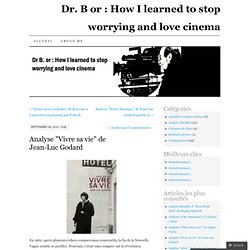
Pourtant, c’était sans compter sur la révolution cinématographique que va engendrer le quatrième film de Godard. Toujours autant aux prises avec son temps et avec les mouvements intellectuels contemporains, Godard rompt avec l’héritage griffithien du montage et réinvente le plan séquence par des cadres et des mouvements de caméra aussi audacieux esthétiquement que justes à l’égard de son propos. <em>Le montage des constellations - Godard et Benjamin</em> : Hélène Bouchardeau. Articles Il y a deux théories sur le cinéma chez Walter Benjamin.
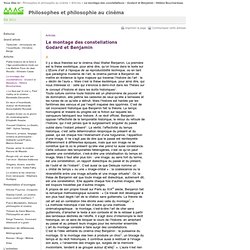
La première est la thèse exotérique, pour ainsi dire, qu’on trouve dans le texte sur L’Œuvre d’art à l’époque de sa reproductibilité technique, où en tant que paradigme moderne de l’art, le cinéma permet à Benjamin de mettre en évidence la ligne majeure qui traverse l’histoire de l’art : le « déclin de l’aura ». Mais c’est la thèse ésotérique, pour ainsi dire, qui nous intéresse ici : celle qui s’énonce à demi-mot dans les Thèses sur le concept d’histoire et dans les écrits historiques1.Toute culture comme toute histoire est un phénomène de pouvoir et de domination, elle piétine les cadavres de ceux qu’elle a terrassés et les ruines de ce qu’elle a détruit. Mais l’histoire est hantée par les fantômes des vaincus et par l’esprit inapaisé des opprimés.
Orson Welles Web Resource » Andrew Sarris vs. Pauline Kael on “Raising Kane” I had never read Andrew Sarris's reply to Pauline Kael's infamous article "Raising Kane," that was first published in The New Yorker in 1971.

So it was a very pleasant surprise to see it turn up in the archive section of The Village Voice online. Mr. Sarris makes many salient points about the numerous flaws in Ms. Kael's piece, which unfortunately was published alongside the original script for Citizen Kane in The Citizen Kane Book.
Detalles a propósito de un plano. : Desde Godard, ida y vuelta. 1 Insisto: “a propósito del detalle”, es decir para ver desde él lo que sería (justo en él), cada vez más cerca (sin evitar su auspiciosa soberanía), el orden de las cosas, “la historia de lo Mismo-de aquello que, para una cultura, es a la vez disperso y aparente y debe, por ello, distinguirse mediante señales y recogerse en las identidades.”
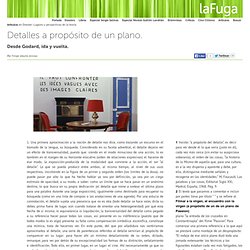
Vamos, alégrame el día...: CASINO: ANÁLISIS DE LA SECUENCIA DE LA DISCURSIÓN DEL DESIERTO ENTRE NICKY SANTORO Y SAM ROTHSTEIN. En esta secuencia, presenciamos una discursión entre Sam Rothstein ( Robert de Niro ), gerente del casino y Nicky Santoro ( Joe Pesci ), mafioso que le cubre las espaldas. El cine, arte sin imágenes, por Paulino Viota. Con urgencia me pide Carlos Heredero unas palabras sobre Godard. Se me ocurre que la idea que define lo más sustancial del arte del cineasta, al menos desde que empezó a hacer películas más de pensamiento que de narración, al menos desde 1+1, cuyo título ya es suficientemente significativo, es la idea de COMPARACIÓN; o sea el prescindir o dejar en segundo término lo que se ha llamado LÍNEA narrativa y jugar con el DOS, con la creación de relaciones en principio duales entre los componentes que maneja la película.
Untitled. Tom Stoppard & Joe Wright on “Anna Karenina” Sites úteis. Sites úteis. Eisenstein, the Glass House and the Spherical Book. 6. The script and the excerpts from the diaries were first published by Naum Kleiman, Iskusstvo kino, No 3 (1979), pp. 94-114; and in French by François Albera and Valérie Posener, Faces. Journal d'architecture (Genf), numéro 24 (Summer 1992), pp. 43-52. Gilles Deleuze's Bergsonian Film Project. In his second book Deleuze tackles temporality in a more direct fashion. Although the book is considerably longer than the first (344 to 250 pages), Deleuze does not propose rigid or neat classifications. The central shift remains from a cinema that defined itself primarily through motion to one that concerned itself more directly with time.
La reescritura del acontecimiento a través de la reescritura de las imágenes. Filmosophy by Daniel Frampton. La imagen del pensamiento en Gilles Deleuze; Tensiones entre cine y filosofía. Lic. A Confrontation with Madness: Punto de Vista International Documentary Film Festival 2013 - Cinema Scope. El Modelo By Andrés Duque Be uncomfortable; be sand, not oil in the machinery of the world. —Gunter Eich Following the 2011 edition of the Punto de Vista International Documentary Film Festival—to which I had been invited to screen my film Colour Runaway Dog—it was announced that, due to austerity measures imposed by the current Spanish government, the festival would be closed indefinitely.
This prompted the local film community, together with hundreds of filmmakers around the world, to sign a petition urging the Council of Culture of Navarra to save the festival in light of “its cultural relevance in the international film scene.” I can only express my gratitude to the people behind the festival for giving us the opportunity to see some of the most subversive works in the non-fiction field. The Jury The Dubai in Me. Bill Nichols. Along with Breaking Bad, True Detective is definitely one of the many impressive series gracing our soon to be defunct TVs (in terms of TV as a medium for banality and the ads that accompany it, and as a stand alone device).
Emily Nussbaum, a very solid TV reviewer at The New Yorker, panned it. I like her reviews and often find them a good guide to viewing, which could be either in the sense of if she likes it, I won’t, or vice versa, but not in this case. Nussbaum finds if cliche ridden, especially in the cops as buddies, the women as eye candy, and the plot as predictable. Has she seen buddy movies that go all the way back to the 1920s, women as eye candy that go just as far back, or plots more subtly woven around slippages in time?
(Emily definitely needs to see more movies.) Movie Poster of the Week: “The Suitor” and the Films of Pierre Etaix on Notebook. Above: The Suitor (Pierre Etaix, France, 1962). French double grande poster (63" x 94.5") by André François. Le Grand Humour: Pierre Étaix in Action. By Sarah Mankoff on October 18, 2012 Like any less recognized gag-based comic, Pierre Étaix invites comparisons to a multitude of his stylistic peers: Keaton, Tati, Linder. It’s not that the man doesn’t have a style of his own—a light, delicate touch pervades his films (even when the most base impulses drive his actions, such as a suddenly awakened libido in The Suitor)—but rather that Étaix excels at so many characters.
Rupture The Suitor. Hitchcock’s Storyboards from 13 Classic Films. Hitchcock was known for his extensive storyboarding down to the finest detail of production. He was reported to have never even bothered looking through the viewfinder, since he didn’t need to do so. Looking at his storyboards versus the finial film it’s safe to say that is a vast overstatement. Hitchcock trained as a draughtsman and worked in advertising before his first job in the film industry; designing title cards for silent films.